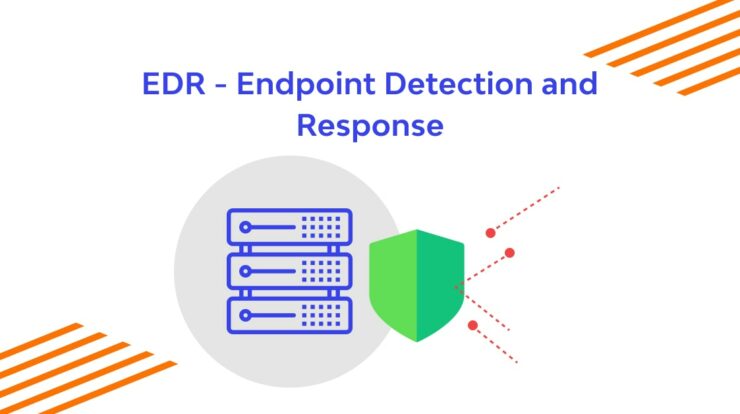
EDR security will safeguard all of your endpoints! Endpoints Detection and Response EDR security is one approach for protecting your endpoints and reducing the risk of intrusions. But, what exactly is an endpoint, and why should it be secured? A network endpoint is any device that connects to a network remotely. The corporate network of your organisation often contains several thousand endpoints. Smart sensors, workstations, PCs, servers, printers, and other peripheral devices are examples.
Employees also utilise personal devices like cell phones, computers, and tablets to log in remotely, increasing the number of endpoints even further. Because hackers can exploit these endpoints to get illegal access to your personal data, they create security weaknesses.
In this essay, I will define EDR and cover various technologies that might help you improve your EDR security.
Let’s get started!
What Exactly Is EDR?
Endpoint detection and response is a cybersecurity system that identifies and responds to endpoint threats automatically. EDR solutions monitor and analyse endpoint use, identify unusual activity, and alert the company’s IT personnel so that attacks may be responded to quickly. EDR security safeguards your network by identifying and limiting endpoint assaults and preventing them from propagating further.
You may be wondering why your company’s cybersecurity team has to pay special attention to EDR now that you know what it is. Allow me to explain.
Why Is EDR Security Critical?
EDR security can be used in place of antivirus software.
Because of their flexible working conditions, most organisations enable employees to connect to corporate networks using personal devices. This implies that staff are accountable for guaranteeing the security of gadgets. Employee carelessness poses a big threat for your company’s IT security.
Employees, for example, may fail to apply antivirus updates and therefore unintentionally download a harmful virus. When they log in, the virus will disguise itself as a trusted device and effectively circumvent your standard security procedures to wreak havoc on your network.
Endpoints are then exploited by cybercriminals, who execute malicious software that spills data and encrypts or locks your IT systems. This creates significant financial losses and interrupts routine corporate operations. EDR rsecurity defends you from threats by providing your security team with the following information:
- Endpoint visibility is provided through a single interface from which the EDR security solution collects and displays data from all connected devices.
- Faster investigation because EDR data gathering allows your security team to quickly obtain context regarding security occurrences.
- EDR tools employ predetermined criteria to respond to abnormal activity, resulting in automatic remediation.
Of course, you can’t put EDR security in place until you understand the technology. I’ll go through how EDR works and the various components of any EDR system in depth.
What Is the Process of Endpoint Detection and Response?
Any EDR security solution will generally have two capabilities: detection and confinement, which operate in tandem to safeguard all of your endpoints. I’ll go over them in depth below.
1. Detection of Threats
EDR security often instals software agents on all endpoints, including new network endpoints. Each endpoint’s software agents gather data such as login attempts, event logs, file data, and running programmes. Following that, the EDR solution use machine learning and artificial intelligence to detect abnormal patterns in the acquired data.
When any suspicious behaviour is discovered, security teams receive an automated alert. For example, if a file on an endpoint device begins to display ransomware behaviour, such as encrypting other files, EDR will identify it. It will also notify your business so that you may take appropriate action.
2. Threat Reduction
When EDR security recognises a danger, it takes quick action to contain the infection. It can, for example, disable the device or isolate specified sections of the network. Before your cybersecurity team can respond to the danger, prompt automated action reduces harm and safeguards your data.
The EDR security system also saves all attack data for your team’s post-attack investigation. You may also use the data to create new policies to avoid similar assaults from happening again in the future.
After explaining how EDR works, I’ll go through various tools you can use to get started with EDR security right now!
The Top Three EDR Security Tools
Following a thorough study, I believe GFI LanGuard, Crowdstrike, and Trellix are the three greatest EDR solutions on the market.
#1. Trellix Endpoint Security
Trellix can help you improve your cybersecurity!
Trellix Endpoint Security (formerly known as FireEye) safeguards your endpoints against known and unknown attacks. Because of their exact threat detection and unified endpoint management, you may expedite attack response. Trellix Endpoint Security provides:
EDR quality has been improved using relevant data.
- Malware protection and treatment are fully integrated.
- Comprehensive analysis in order to undertake a thorough examination and inquiry
- I hope one of these will meet your EDR needs. Now for a brief summary!
#2. Crowdstrike Falcon Insight EDR
Crowdstrike provides superior endpoint security!
Crowdstrike’s Falcon Insight EDR analyses all endpoint activities in real-time. This way, you can see exactly what’s going on—from a single endpoint to the entire organisation. You will receive:
- Continuous raw event recording ensures unrivalled visibility.
- Memory scanning at high speeds on all endpoint devices to identify the most subtle threats
- Strong reaction steps, such as remote access for your security staff to swiftly fix affected systems
#3. GFI LanGuard
Get cutting-edge EDR security solutions!
GFI LanGuard is an all-in-one EDR solution that allows you to monitor and maintain end-point security across your network. It gives you automatic insight into all network aspects, assists you in identifying possible vulnerabilities, and facilitates automated software patching and upgrades. You may use GFI LanGuard to:
- Automatically discover all network endpoints and elements, including devices, virtual computers, switches, and routers.
- Distribute management tasks among various teams by grouping your devices.
- A centralised administration dashboard allows you to see all of your endpoints.
Last Thoughts
Endpoint detection and response is a cybersecurity approach that is used to secure and safeguard network endpoint devices. Endpoint data is aggregated and automatically analysed by EDR security systems to detect malicious behaviour and abnormalities. They also allow security personnel to swiftly identify, investigate, and respond to issues. As a result, EDR security should be a top priority in your organization’s cybersecurity strategy!
Do you have any further questions about EDR security? Please see the FAQ and Resources pages for further information!
FAQ
What exactly is the distinction between endpoint protection and endpoint detection?
Endpoint protection (EPP) refers to cybersecurity systems that prioritise threat prevention prior to attacking endpoints. EDR tools, on the other hand, accept that you will never have total security and must prepare for an assault. EDR security enables you to respond to cyber-attacks and incidents more quickly and efficiently.
What is the distinction between EDR and MDR?
MDR (managed detection and response) is a third-party service that assists your organisation in responding to cyberattacks. In the event of an attack, an external third party conducts countermeasures. EDR, on the other hand, is a subset of cybersecurity that concentrates on responding to network endpoint threats. EDR can be implemented in-house or through a third party.
What is the distinction between EDR and XDR?
XDR is the next step in the evolution of EDR. While EDR is confined to identifying malicious behaviour on network endpoints, XDR detects assaults on servers, network devices, and the cloud automatically.
Yes. Traditional antivirus can be replaced with EDR security. EDR systems often incorporate all classic antivirus functions, such as network monitoring and malware detection. They go above and beyond, however, to offer automated threat detection and response.
Does EDR prevent ransomware?
Yes. EDR systems help protect against ransomware and other cyber attacks. EDR security identifies ransomware activity, such as encryption, and alerts your cybersecurity team to take action. Finally, EDR can prevent ransomware from propagating throughout the network by blocking it.






